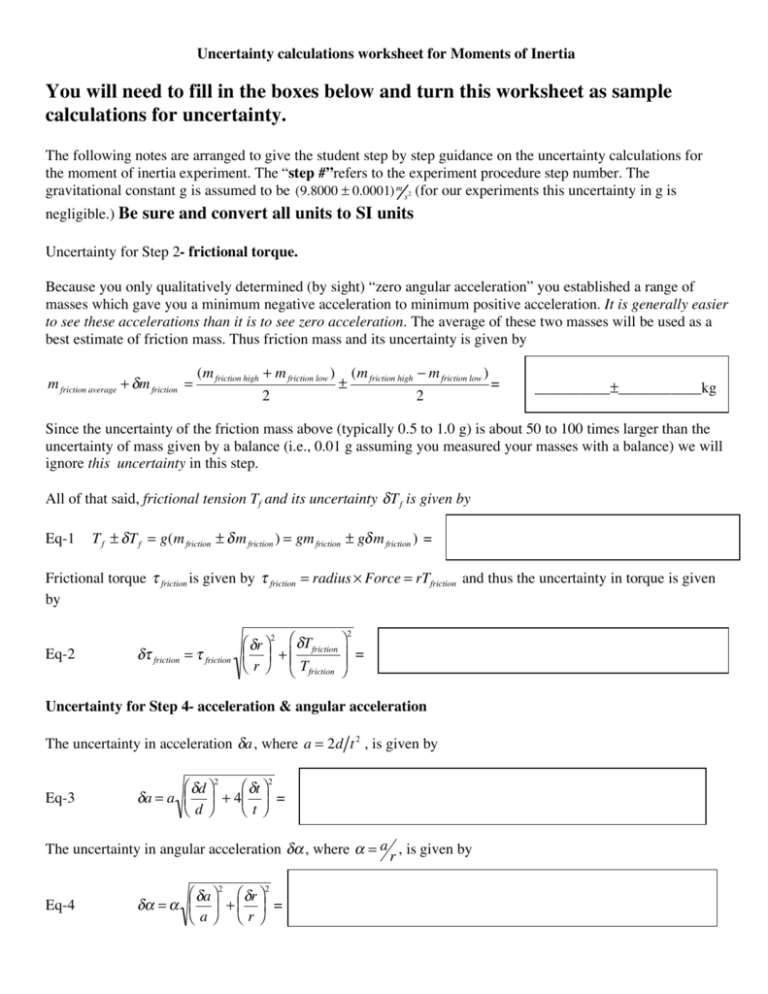Moment of Inertia experiment uncertainty calculations
advertisement

Uncertainty calculations worksheet for Moments of Inertia
You will need to fill in the boxes below and turn this worksheet as sample
calculations for uncertainty.
The following notes are arranged to give the student step by step guidance on the uncertainty calculations for
the moment of inertia experiment. The “step #”refers to the experiment procedure step number. The
gravitational constant g is assumed to be (9.8000 ± 0.0001) m s2 (for our experiments this uncertainty in g is
negligible.) Be sure and convert all units to SI units
Uncertainty for Step 2- frictional torque.
Because you only qualitatively determined (by sight) “zero angular acceleration” you established a range of
masses which gave you a minimum negative acceleration to minimum positive acceleration. It is generally easier
to see these accelerations than it is to see zero acceleration. The average of these two masses will be used as a
best estimate of friction mass. Thus friction mass and its uncertainty is given by
m friction average + !m friction =
(m friction high + m friction low ) (m friction high " m friction low )
=
±
2
2
__________±___________kg
Since the uncertainty of the friction mass above (typically 0.5 to 1.0 g) is about 50 to 100 times larger than the
uncertainty of mass given by a balance (i.e., 0.01 g assuming you measured your masses with a balance) we will
ignore this uncertainty in this step.
All of that said, frictional tension Tf and its uncertainty ! T f is given by
Eq-1
T f ± ! T f = g(m friction ± ! m friction ) = gm friction ± g! m friction ) =
Frictional torque ! friction is given by ! friction = radius " Force = rTfriction and thus the uncertainty in torque is given
by
Eq-2
!" friction = " friction
2
# !r & 2 # !Tfriction &
( =
% ( + %%
$ r ' $ Tfriction ('
Uncertainty for Step 4- acceleration & angular acceleration
The uncertainty in acceleration !a , where a = 2d t 2 , is given by
Eq-3
" !d % 2
" !t % 2
!a = a $ ' + 4$ ' =
#d&
#t&
The uncertainty in angular acceleration !" , where ! = a r , is given by
Eq-4
# !a & 2 # !r & 2
!" = " % ( + % ( =
$a' $r'
Uncertainty calculations worksheet for Moments of Inertia
Uncertainty for step 5-string tension (assume all masses have a one percent uncertainty)
String tension is given by T = m(g ! a) = mg ! ma . Thus, you will first determine ! (mg) and ! (ma) and then
add the two uncertainties in quadrature.
Eqs 5 & 6
! (mg) = g!m
and
" ! m % 2 " !a % 2
! (ma) = ma $ ' + $ ' =
#m& #a&
The uncertainty !T for the sum (actually difference) of the tension is given by
!T = [! (mg)] + [! (ma)]
Eq-7
Uncertainty for step 6- torque and net torque
2
2
=
The uncertainty in torque !" is given by
Eq-8
# !T & 2 # !r & 2
!" = " % ( + % ( =
$T' $r'
The uncertainty, !" net , in net torque, !" net = " # " friction , is given by
Eq-9
!" net =
(!" )2 + (!" friction )
2
=
Uncertainty for step 8- moment of inertia
The experimental moment of inertia is given by I0 exp = ! net /" and the uncertainty, !" , is given by
Eq-10
!I0 exp = I0 exp
# !" net & 2 # !) & 2
%
( +% ( =
$ " net ' $ ) '
Uncertainty for step 9- additional masses (assume masses have one percent uncertainties)
The relationship for additional masses is given by Ical = I0 exp + MR 2 , where the uncertainty, ! (MR 2 ) in the term
MR 2 , is given by
Eq-11
" !M % 2
" !R % 2
! (MR 2 ) = MR 2 $
' + 4$ ' =
#M&
#R&
The uncertainties ! (MR 2 ) and !Iexp are now added in quadrature to obtain !Ical . Show this below








